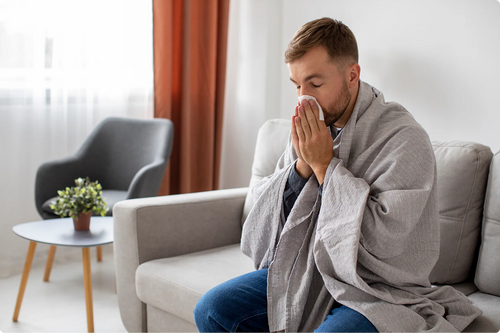Disclaimer: This article is for informational purposes only and is not a substitute for professional medical advice. Always consult a healthcare provider if you experience persistent or worsening symptoms.
As the temperature drops, cases of the common cold seem to rise. While we often blame the chilly weather for our sniffles, the real culprit is the rhinovirus, the primary cause of the common cold. Research has shown that rhinovirus thrives in cooler temperatures, making it easier for infections to take hold. Understanding the role of temperature in rhinovirus growth can help us take practical steps to stay warm and reduce our risk of getting sick during cold and flu season.
In this article, we’ll explore how temperature affects rhinovirus replication, how heat shock proteins play a role in immune response, and what you can do to stay healthy using techniques like heated dry air therapy, sauna sessions, and other natural methods.
Why Rhinovirus Prefers Cold Temperatures
Studies have shown that rhinovirus replicates best at temperatures between 91-95°F, which is the average temperature inside the nasal passages. However, when nasal temperatures drop below this range, the virus replicates more efficiently, increasing the likelihood of infection.
A 2016 study published in the Proceedings of the National Academy of Sciences found that cooler temperatures reduce the body’s antiviral response, making it harder for immune cells to stop the virus from multiplying. This is because heat shock proteins (HSPs), which help protect cells from stress, are less active in cooler temperatures. When nasal tissues are exposed to warmth, heat shock proteins become more effective at enhancing immune function, reducing the spread of rhinovirus.

How to Stay Warm and Reduce Your Risk of Getting Sick
1. Dress in Layers and Keep Extremities Warm
Keeping your body warm during winter is essential to maintaining overall respiratory wellness. Cold extremities can trigger constriction of blood vessels in the nose, lowering the temperature inside your nasal passages and making it easier for rhinovirus to thrive.
- Wear insulated gloves, hats, and scarves when going outside.
- Use warm socks and footwear to prevent body heat loss.
- Drink warm beverages like herbal tea to help regulate internal body temperature.
2. Take Advantage of Sauna Sessions
Regular sauna use has been shown to enhance respiratory wellness and reduce the likelihood of colds. A 2017 Finnish study found that people who used saunas multiple times per week had significantly lower rates of respiratory infections. The high temperatures in a sauna help stimulate circulation, promote detoxification, and support immune function. Spending time in a sauna can also activate heat shock proteins, boosting your body’s ability to fight off infections.
3. Use Heated Dry Air Therapy
One of the most effective ways to maintain nasal warmth is through heated dry air therapy. Devices like SinuSauna deliver targeted warm air directly to the nasal passages, helping to maintain an optimal temperature that discourages rhinovirus growth.
Heated dry air therapy not only temporarily warms nasal tissues warm but also supports avoiding congestion, helping those suffering from sinusitis and seasonal allergies breathe easier.
4. Stay Hydrated and Humidify Your Environment
Dry indoor air can contribute to nasal irritation, making it easier for viruses to take hold. Using a humidifier or incorporating steam inhalation can help maintain mucosal moisture and support sinus relief.
Pairing a humidifier with heated dry air therapy ensures that your nasal passages remain warm while still receiving the moisture they need for optimal respiratory wellness.

Final Thoughts: Fight Colds by Staying Warm
While we can’t completely avoid exposure to rhinovirus, we can take proactive steps to reduce our risk of infection by keeping our nasal passages warm and supporting our immune system.
Incorporating strategies like heated dry air therapy, sauna use, proper layering, and hydration can help maintain sinus relief, congestion relief, and allergy relief throughout the colder months. By understanding the link between temperature and rhinovirus growth, we can stay healthier and breathe easier during cold and flu season.






